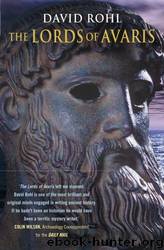The Lords Of Avaris by David Rohl

Author:David Rohl [Rohl, David]
Language: eng
Format: epub, mobi
ISBN: 9781407010922
Publisher: Random House
Published: 2010-04-05T16:00:00+00:00
Chapter Twelve
DANAUS AND AEGYPTUS
Mycenaean Shaft Graves –– The Last of the Shemau –– Hesiod’s Races of Men –– The Atreid Dynasty of Mycenae
I HAVE PROPOSED that the Greater Hyksos kings of Egypt, ruling from Memphis and Avaris, were one of the last elements of a great movement of northerners into the Fertile Crescent which began at the end of the Early Bronze Age (NC – c. 2100 BC) and ended during the last phase of the Middle Bronze Age (NC – c. 1200 BC). These Greater Hyksos were of Hurrian and Indo-European stock. Salitis and Bnon may have been leaders of the Aryan Umman Manda of northern Mesopotamia and the Zagros mountains, their successors – Khyan, Yanassi, Apophis and Khamudy – of Aegean origin, more specifically the people Homer called ‘Divine Pelasgians’. The original homeland of these Pelasgians was the northern shore of the Black Sea before they moved into mainland Greece (focused on the Plain of Argolis) at the beginning of the Middle Bronze Age. They then spread throughout the Aegean and along the Anatolian and Phoenician coasts.
Herodotus [Book I] tells us that these original Pelasgians did not speak Greek and it is my view that the language spoken by Khyan and his line was an early branch of Indo-European using the distinctive locative suffix endings, including -sos, -ndos and -ntha/-nthos, reflected in names such as Knossos, Amnissos, Lindos, Tirynthos (Tiryns), and words such as kissos (ivy), kyparissos (cypress tree), olynthos (wild fig), plinthos (brick). This Pelasgian linguistic trait is found in Greece, Crete and Anatolia – associated with the Western Luwian speakers of the latter region. In the earliest Hittite texts we hear of the land of Luwili from where the Luwian language originated. This part of western Anatolia was later known as Arzawa – a general term which included (from north to south) the kingdoms of Wilusa, the Seha River Lands, Mira and Haballa. It seems very likely that the aristocracy of Wilusa/Ilios were Luwian-speakers because a seal was recently found at Hissarlik by Donald Easton which is claimed to be ‘the first attested prehistoric inscription from Troy’.1 The script on the seal is in Luwian.
This group of Luwian-speakers had crossed the Hellespont and Bosporus from Europe to settle in north-western Anatolia. Their descendants were the Dardanians and Trojans of Wilusa (Ilios) and Arzawans of Sardis (in the land of Mira, later known as Lydia) and Epasa (Ephesus). Other Indo-European speakers moved down from the Caucasus region and occupied the uplands of eastern Anatolia (the Hittites), northern Mesopotamia (the Aryans) and southern Anatolia, centred on the major trading and metal-working city-states such as Purushanda (probably Kara Hüyük near modern Konya, Classical Iconium). From the coastal areas these Indo-Europeans expanded onto the eastern Mediterranean islands – especially Cyprus, Crete and Thera – and, of course, mainland Greece.
68. The small round two-sided seal found in the Troy VIIa level at Hissarlik by Donald Easton during the recent German excavations led by Manfred Korfmann. The language of the text is Luwian [after Latacz, 2004, p.
Download
This site does not store any files on its server. We only index and link to content provided by other sites. Please contact the content providers to delete copyright contents if any and email us, we'll remove relevant links or contents immediately.
The Vikings: Conquering England, France, and Ireland by Wernick Robert(79846)
Ali Pasha, Lion of Ioannina by Eugenia Russell & Eugenia Russell(40106)
The Conquerors (The Winning of America Series Book 3) by Eckert Allan W(37094)
The Vikings: Discoverers of a New World by Wernick Robert(36903)
Cecilia; Or, Memoirs of an Heiress — Volume 1 by Fanny Burney(32396)
Cecilia; Or, Memoirs of an Heiress — Volume 3 by Fanny Burney(31782)
Cecilia; Or, Memoirs of an Heiress — Volume 2 by Fanny Burney(31753)
Empire of the Sikhs by Patwant Singh(22928)
The Secret History by Donna Tartt(18788)
Hans Sturm: A Soldier's Odyssey on the Eastern Front by Gordon Williamson(18448)
Cat's cradle by Kurt Vonnegut(15127)
Pimp by Iceberg Slim(14267)
Sapiens: A Brief History of Humankind by Yuval Noah Harari(14186)
Talking to Strangers by Malcolm Gladwell(13160)
Norse Mythology by Gaiman Neil(13156)
Leonardo da Vinci by Walter Isaacson(13131)
4 3 2 1: A Novel by Paul Auster(12245)
Underground: A Human History of the Worlds Beneath Our Feet by Will Hunt(11992)
The Radium Girls by Kate Moore(11886)
